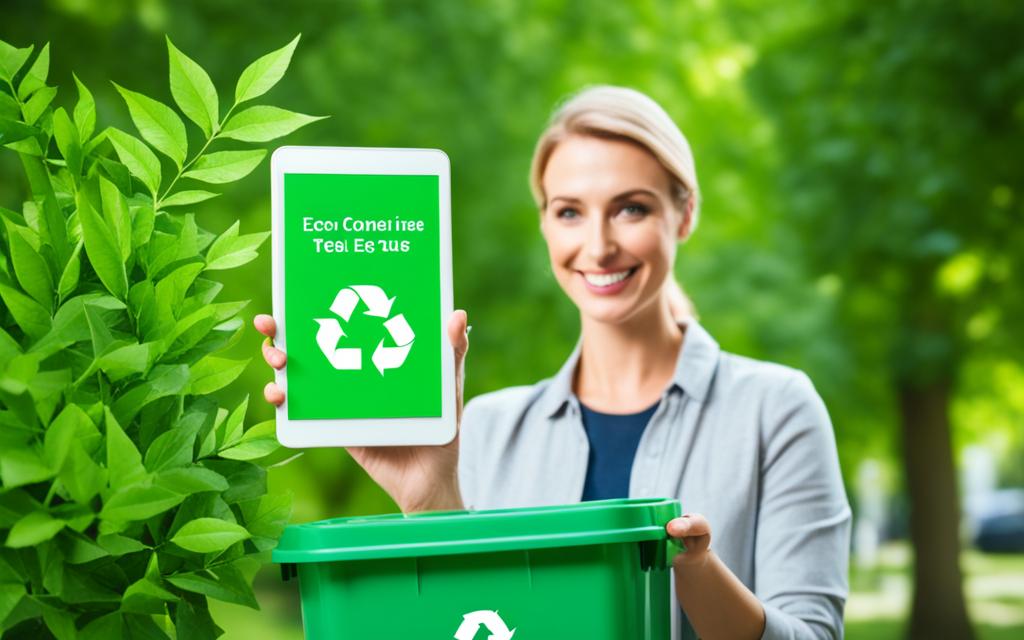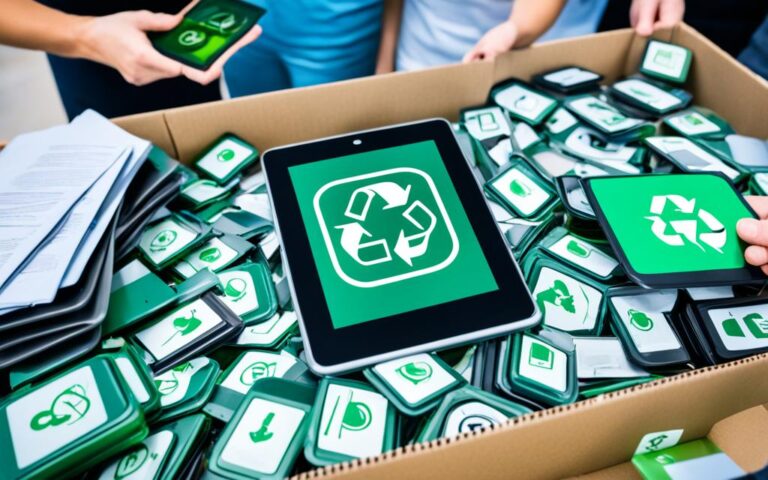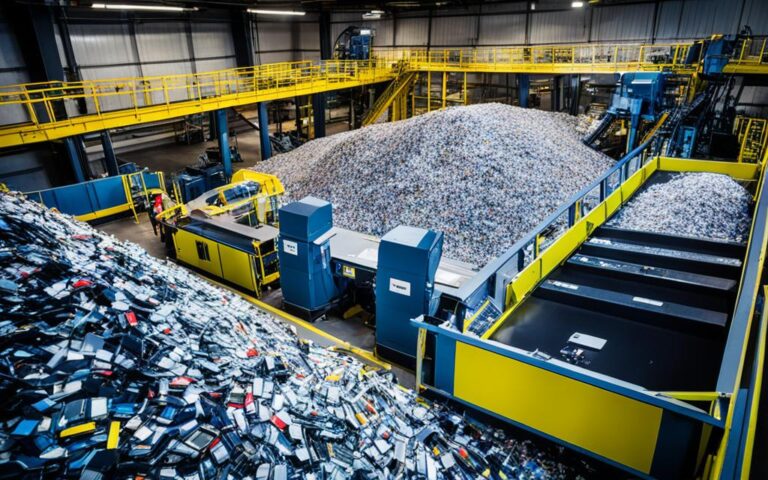How to Reduce Your Digital Footprint with Phone and Tablet Recycling
Are you concerned about the environmental impact of your digital devices? Phones and tablets have become essential parts of our lives, but they also contribute to a significant issue: e-waste. The materials used in these devices, such as plastics, glass, metal, and aluminum, can be recovered and reused, making recycling an essential step in reducing our digital footprint.
Why is it important to recycle electronic waste? E-waste contains hazardous substances like lead, mercury, and cadmium, which can pollute the environment if not disposed of properly. By choosing responsible recycling options, we can ensure these toxic materials are handled safely and prevent them from causing harm.
Fortunately, there are many programs and options available for phone and tablet recycling. Companies like Dell, Apple, and Best Buy offer recycling programs, as well as online platforms like eBay. Sprint’s Buyback program and Amazon gift cards are other options worth considering. By participating in these recycling initiatives, we can play our part in reducing e-waste and minimizing our digital footprint.
Before recycling your electronic device, it is essential to ensure the complete erasure of personal information. Taking steps to protect your privacy is crucial in this digital age, and wiping your device clean ensures that your data remains secure.
Join the movement towards a greener future by embracing phone and tablet recycling. By reducing our digital footprint, we can make a positive impact on the environment and pave the way for a sustainable tomorrow.
The Impact of Data Consumption on Carbon Footprint
Our collective data consumption has a direct impact on our carbon footprint. The use of devices like phones and tablets for activities such as browsing, streaming, and downloading requires electricity, contributing to the carbon footprint. Additionally, the processing and storage of the vast amount of data generated by these devices also have an environmental impact.
To reduce the environmental impact of tech use, there are simple steps that can be taken:
- Recycle or repair devices: Instead of disposing of old phones and tablets, consider recycling or repairing them. Many components can be reused or repurposed, reducing the carbon footprint associated with manufacturing new devices.
- Unplug devices when not in use: Leaving devices plugged in and on standby mode still consumes energy. Unplugging them when not in use helps reduce unnecessary electricity consumption.
- Be mindful of email usage: Limiting the number of emails sent and received can reduce the storage requirements of email servers, which in turn reduces their energy consumption.
- Stream content as a team: Streaming content with friends or family reduces the individual data consumption by sharing the same video or music stream.
- Play games and apps offline: Whenever possible, choose to play games or use apps offline. This reduces the data consumption associated with online gameplay or app usage.
By adopting these practices, individuals can make a significant difference in reducing their digital footprint and minimizing the environmental impact of their data consumption.
Why Digital Data Consumption Matters
“Our digital activities have consequences beyond the screens we interact with. Every email, video streamed, or app downloaded involves processing and storing data, which consumes energy and contributes to carbon emissions.” – GreenTech Sustainable Solutions
Data centers, which are responsible for storing, processing, and transmitting the massive amount of digital data generated worldwide, have a significant carbon footprint. The energy-intensive operations of these data centers, coupled with the cooling needs to maintain optimal server temperatures, contribute to greenhouse gas emissions.
Reducing our digital footprint goes beyond individual actions. It requires collective efforts from individuals, businesses, and organizations to minimize the energy consumed by data centers and optimize their cooling processes.
Making Electronics Last and Responsible E-waste Recycling
Extending the lifespan of electronics is the most effective way to reduce the carbon footprint of digital devices. By practicing responsible e-waste recycling and adopting sustainable habits, we can minimize the environmental impact of our electronic consumption. Here are some key actions you can take:
1. Repairing, Upgrading, and Repurposing
Instead of discarding old electronics, consider repairing or upgrading them to extend their lifespan. Many manufacturers offer repair services or provide replacement parts, making it easier to fix common issues. Additionally, repurposing devices for other uses, such as turning an old tablet into a digital photo frame, can give them a new lease of life.
2. Selling, Trading In, or Donating
If you no longer need a device, consider selling it, trading it in, or donating it. There are online platforms where you can sell your used electronics, giving them a second chance with a new owner. Some manufacturers and retailers also offer trade-in programs, allowing you to exchange your old device for credit towards a new purchase. Donating to charities or organizations that refurbish and distribute electronics to those in need is another excellent way to prevent e-waste.
3. The Carbon Footprint of Manufacturing
It’s important to note that the carbon footprint of electronics encompasses not only their use and disposal but also their manufacturing process. The extraction of raw materials, energy consumption, and transportation involved in manufacturing contribute significantly to carbon emissions. By making our electronics last, we can reduce the demand for new devices and consequently minimize the environmental impact of the manufacturing process.
4. Responsible E-waste Recycling
Despite the growing awareness of the importance of recycling, only a small percentage of old phones, computers, and electronics are recycled annually. It’s crucial to choose responsible e-waste recycling options. Look for recycling programs or drop-off locations provided by manufacturers, retailers, and local authorities. Certification standards such as R2 and e-Stewards ensure that e-waste is handled properly and prevents its export to low-income countries where it may be improperly disposed of.
It’s our responsibility to make conscious choices regarding our electronic devices. Whether through repairing, upgrading, repurposing, selling, trading in, or donating old electronics, we can contribute to reducing e-waste. Additionally, by selecting responsible e-waste recycling options, we can ensure that our electronics are disposed of in an environmentally friendly manner.
The table below highlights the environmental impact of recycling compared to landfilling electronic devices:
| Environmental Impact | Recycling | Landfilling |
|---|---|---|
| Reduces carbon emissions | ✓ | ❌ |
| Prevents toxic substances from entering the environment | ✓ | ❌ |
| Conserves valuable resources | ✓ | ❌ |
| Supports the circular economy | ✓ | ❌ |
Recycling your electronics not only reduces the carbon footprint but also helps preserve valuable resources and prevents toxic substances from polluting the environment. It is our collective responsibility to prioritize responsible e-waste recycling in order to create a more sustainable future.
Options for Recycling Computers and Smartphones
When it comes to computer recycling and smartphone recycling, it’s important to choose the right options for a sustainable future. The materials present in these devices are highly valuable and can be recovered and reused instead of ending up as e-waste.
While recycling computers and smartphones should ideally be free, there may be a modest fee associated with recycling flatscreen and CRT displays and TVs. However, this small fee is a worthwhile investment in the responsible disposal of these items and the preservation of our environment.
Fortunately, several stores and manufacturers offer recycling programs for electronics, ensuring that these devices are handled responsibly. Some notable options include Dell, HP, Samsung, Apple, Microsoft, and Google. These companies are committed to sustainability and provide accessible and convenient avenues for recycling old devices.
For those looking to upgrade their devices, trade-in credit programs are available at select stores and wireless carriers. These programs allow you to trade your old computer or smartphone for credit towards a new purchase, while also ensuring that your old device will be properly recycled and its valuable materials recovered.
If dropping off your electronics or mailing them in is more convenient for you, there are options like Best Buy, Goodwill, Staples, and Amazon. These retailers have dedicated drop-off locations where you can safely and responsibly dispose of your outdated or no longer needed devices.
The long-term benefits of responsible recycling cannot be overstated. By recycling computers and smartphones, we can significantly reduce e-waste and its harmful effects on the environment. Additionally, recycling allows for the conservation of valuable resources and the creation of a more sustainable future.
“Recycling turns things into other things, which is like MAGIC.” – Unknown
Conclusion
Reducing our digital footprint and responsibly recycling electronic devices are crucial steps towards sustainability. As our reliance on technology continues to grow, it becomes essential to address the environmental impact of our digital habits. By making conscious decisions and adopting sustainable practices, we can significantly contribute to the reduction of e-waste and the preservation of our planet.
Fortunately, there are various recycling options and programs available that make it easy for individuals to play their part in reducing e-waste. Whether it’s through established programs like Dell Reconnect or Apple’s GiveBack program, or by simply dropping off old devices at Best Buy or Staples, every effort counts. Recycling not only helps recover valuable materials but also ensures the safe disposal of toxic substances found in electronics like phones and tablets.
However, our responsibility doesn’t end with recycling alone. We must also strive to extend the lifespan of our devices by repairing, upgrading, or repurposing them whenever possible. By doing so, we reduce the demand for new electronics and minimize the carbon footprint associated with their manufacturing and disposal.
Embracing sustainable digital habits and reducing our digital footprint is a collective effort that benefits both present and future generations. Let’s continue to educate ourselves about the importance of responsible e-waste management and inspire others to join us in this crucial endeavor. Together, we can make a positive impact on the environment and work towards a more sustainable future.
FAQ
Why is phone and tablet recycling important?
Phone and tablet recycling is important because electronics like phones and tablets contribute to e-waste, which has a significant environmental impact. By recycling these devices, we can recover and reuse materials like plastics, glass, metal, and aluminum.
What are the environmental risks associated with electronic waste?
Electronic waste contains toxic substances like lead, mercury, and cadmium. If not disposed of properly, these toxins can harm the environment. Safely disposing of electronic waste is crucial to prevent these substances from polluting our landfills and water sources.
What programs and options are available for phone and tablet recycling?
There are several programs and options for phone and tablet recycling. Some popular options include Dell Reconnect, World Computer Exchange, eBay for Charity, Amazon gift cards, Apple’s GiveBack program, Best Buy, Office Depot, Staples, and phone manufacturer programs like Sprint’s Buyback.
How can I ensure the complete erasure of personal information before recycling my electronic device?
Before recycling an electronic device, it is crucial to ensure the complete erasure of personal information. You can do this by performing a factory reset and removing any associated accounts and data. It is also advisable to consult the device’s user manual or contact the manufacturer for specific instructions.
How does our data consumption impact our carbon footprint?
Our collective data consumption has a direct impact on our carbon footprint. Charging and using devices like phones and tablets consume electricity, contributing to the carbon footprint. Additionally, the data centers required to process the vast amount of data generated also have an environmental impact.
What steps can I take to reduce the environmental impact of tech use?
There are several simple steps you can take to reduce the environmental impact of tech use. These include recycling or repairing devices, unplugging devices when not in use, being mindful of email usage, streaming content as a team, and playing games and apps offline. Extending the lifespan of electronics is the most effective way to reduce their carbon footprint.
How can repairing, upgrading, repurposing, selling, trading in, or donating old electronics help prevent e-waste?
Repairing, upgrading, repurposing, selling, trading in, or donating old electronics can help prevent e-waste. Instead of disposing of them, these actions allow the devices to be used for a longer time, reducing the need for new ones and the associated environmental impact of manufacturing and disposing of electronic devices.
What certification standards ensure responsible e-waste recycling?
Certification standards like R2 and e-Stewards ensure responsible e-waste recycling. These standards ensure proper handling of e-waste and prevent the export of electronic waste to low-income countries, where it can contribute to environmental and health hazards.
Are there recycling programs for computers and smartphones?
Yes, various stores and manufacturers offer recycling programs for computers and smartphones. Some popular options include Dell, HP, Samsung, Apple, Microsoft, and Google. Additionally, certain stores and wireless carriers offer trade-in credit programs for old devices.
Where can I drop off or mail in electronics for recycling?
There are several options for dropping off or mailing in electronics for recycling. Best Buy, Goodwill, Staples, and Amazon are some of the available options. You can check their websites or contact their customer service for specific details on the recycling process.
How does responsibly recycling electronic devices contribute to sustainability?
Responsibly recycling electronic devices is a crucial step towards sustainability. By reducing e-waste and properly disposing of toxic substances, we can minimize the environmental impact of electronic devices. This collective effort helps preserve our natural resources and create a greener future for generations to come.















